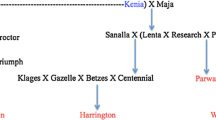Summary
Calli derived from immature embryos of barley and wheat genotypes were screened for their resistance to purified culture filtrate produced by the fungus Helminthosporium sativum P.K. and B. Two selection methods were used: a continuous method in which four cycles of selection were performed one after another on toxic medium and a discontinuous method in which a pause on non-toxic medium was given after the second or third cycle of selection. The latter was superior as it allowed the calli to regain their regeneration ability. About 3,000 calli from two barley genotypes and 2,000 from two wheat genotypes were used for selection. The selection with the pathotoxins resulted in 6% to 17% surviving calli. Toxin tolerant callus lines of barley were characterised by protein isozymes. Zymograms showed one more isozyme than with the unselected sensitive callus. Barley and wheat plants have been regenerated from callus lines surviving the toxin treatment and in vivo testing against pathogen revealed that the majority of these plants were less sensitive.
Similar content being viewed by others
References
Bayliss MW, Dunn S (1979) Factors affecting callus formation from embryos of barley (Hordeum vulgare). Plant Sci Lett 14:311–316
Behnke M (1979) Selection of potato callus for resistance to culture filtrates of Phytophthora infestans and regeneration of plants. Theor Appl Genet 55:69–71
Behnke M (1980) Selection fo dihaploid potato callus for resistance to the culture filtrate of Fusarium oxysporum. Z Pflanzenzücht 85:254–258
Brettell RIS, Thomas E, Ingram DS (1980) Reversion of Texas male sterile cytoplasm maize in culture to give fertile, T-toxin resistant plants. Theor Appl Genet 58:55–58
Chawla HS, Wenzel G (1987) Regeneration potential of callus from wheat and barley. Arch Züchtungsforsch 17:337–343
Eapen S, Rao PS (1985) Plant regeneration from immature inflorescense callus cultures of wheat, rye and triticale. Euphytica 34:153–159
Gengenbach BG, Green CE (1975) Selection of T-cytoplasm maize callus cultures resistant to Helminthosporium maydis race T pathotoxin. Crop Sci 15:645–649
Goldstein CS, Kronstad WE (1986) Tissue culture and plant regeneration from immature embryo expiants of barley, Hordeum vulgare. Theor Appl Genet 71:631–636
Hanzel JJ, Miller JP, Brinkman MA, Fendos E (1985) Genotype and media effects on callus formation in barley. Crop Sci 25:27–31
Hartman CL, McCoy TJ, Knous TR (1984) Selection of alfalfa (Medicago sativa) cell lines and regeneration of plants resistant to the toxin(s) produced by Fusarium oxysporum f. sp. medicaginis. Plant Sci Lett 34:183–194
Ludwig RA (1957) Toxin production by Helminthosporium sativum and its significance in disease development. Can J Bot 35:291–304
Luke HH, Wheeler HE (1955) Toxin production by Helminthosporium victoriae. Phytopathology 45:453–458
Pringle RB (1976) Comparative biochemistry of the phytopathogenic fungus Helminthosporium: XVI. The production of victoxinine by H. sativum and H. victoriae. Can J Biochem 54:783–787
Pringle RB, Braun CA (1957) The isolation of the toxin of Helminthosporium victoriae. Phytopathology 47:369–371
Pringle RB, Scheffer RP (1963) Purification of the selective toxin of Periconia circinata. Phytopathology 53:785–787
Rines HW, Luke HH (1985) Selection and regeneration of toxin-insensitive plants from tissue cultures of oats (Avena sativa) susceptible to Helminthosporium victoriae. Theor Appl Genet 71:16–21
Sacristan MD (1985) Selection for disease resistance in Brassica cultures. Hereditas (Suppl) 3:57–63
Schuchmann R (1985) In vitro Selektion auf Fusarium-Resistenz bei der Kartoffel. Dissertation, TU München
Sears RG, Deckard EL (1982) Tissue culture variability in wheat: callus induction and plant regeneration. Crop Sci 22:546–550
Thanutong P, Furusawa I, Yamamoto M (1983) Resistant tobacco plants from protoplast derived calluses selected for their resistance to Pseudomonas and Alternaria toxins. Theor Appl Genet 66:209–215
Wenzel G (1985) Strategies in unconventional breeding for disease resistance. Ann Rev Phytopathol 23:149–172
Author information
Authors and Affiliations
Additional information
Communicated by G. Melchers
Rights and permissions
About this article
Cite this article
Chawla, H.S., Wenzel, G. In vitro selection of barley and wheat for resistance against Helminthosporium sativum . Theoret. Appl. Genetics 74, 841–845 (1987). https://doi.org/10.1007/BF00247566
Received:
Accepted:
Issue Date:
DOI: https://doi.org/10.1007/BF00247566




